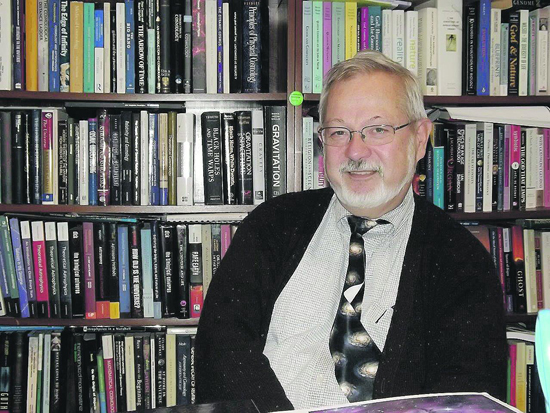 | | | SMC physics and astronomy professor Ronald Olowin, Ph.D. Photo Cathy Dausman
| | | | | | It's not a star, but it is a media darling and according to Saint Mary's College professor and astronomer Ron Olowin, Ph.D. "everybody's following it."
 "It" is Comet ISON, from the outer solar system's Oort Cloud, which came so close in its orbit around the sun Nov. 28 that scientists thought it had disintegrated completely. Hopes were raised when video captured by the ESA/NASA Solar and Heliospheric Observatory showed a dim streak of white material streaming away from the sun, suggesting that a small nucleus was intact.
"It" is Comet ISON, from the outer solar system's Oort Cloud, which came so close in its orbit around the sun Nov. 28 that scientists thought it had disintegrated completely. Hopes were raised when video captured by the ESA/NASA Solar and Heliospheric Observatory showed a dim streak of white material streaming away from the sun, suggesting that a small nucleus was intact.
 But according to a Dec. 2 NASA report, "Whether that spot of light was merely a cloud of dust that once was a comet, or if it still had a nucleus ... is still unclear. It seems likely that as of Dec. 1 there was no nucleus left. By monitoring its changes in brightness over time, scientists can estimate whether there's a nucleus or not, but our best chance at knowing for sure will be if the Hubble Space Telescope makes observations later in December."
But according to a Dec. 2 NASA report, "Whether that spot of light was merely a cloud of dust that once was a comet, or if it still had a nucleus ... is still unclear. It seems likely that as of Dec. 1 there was no nucleus left. By monitoring its changes in brightness over time, scientists can estimate whether there's a nucleus or not, but our best chance at knowing for sure will be if the Hubble Space Telescope makes observations later in December."
 Although the remnants of ISON may not be visible, Olowin will discuss the significance of the comet event and how it relates to astronomy through the ages from 4:30 to 7:30 p.m. Monday, Dec. 9 at the Lafayette Library and Learning Center outdoor amphitheater. Children can also make a fun comet craft at this free event.
Although the remnants of ISON may not be visible, Olowin will discuss the significance of the comet event and how it relates to astronomy through the ages from 4:30 to 7:30 p.m. Monday, Dec. 9 at the Lafayette Library and Learning Center outdoor amphitheater. Children can also make a fun comet craft at this free event.
 Because comets are largely icy snowballs with gas and debris filled tails extending for millions of miles, Olowin says "comets come and go," referencing Comet Halley's winter 1986 appearance and Hale-Bopp in 1997. Comets simply bring more artifacts from the outer solar system down to Earth, Olowin explained from his college office, a galaxy-themed tie bedecking his shirt. A dozen more astronomy and science-themed ties were draped close by - the professor selects his tie to match his lecture material. "You and I are star stuff," he said.
Because comets are largely icy snowballs with gas and debris filled tails extending for millions of miles, Olowin says "comets come and go," referencing Comet Halley's winter 1986 appearance and Hale-Bopp in 1997. Comets simply bring more artifacts from the outer solar system down to Earth, Olowin explained from his college office, a galaxy-themed tie bedecking his shirt. A dozen more astronomy and science-themed ties were draped close by - the professor selects his tie to match his lecture material. "You and I are star stuff," he said.
 If ISON behaves, he said, earthlings can learn more about the quality of water and organic materials contained within. But even without the spectacle of a comet, he noted that looking skyward creates a "harvest of wonder" for us all.
If ISON behaves, he said, earthlings can learn more about the quality of water and organic materials contained within. But even without the spectacle of a comet, he noted that looking skyward creates a "harvest of wonder" for us all.
 For event details, visit www.lafayettelib.org/calendar/programs/family.html. For more information about Comet ISON, visit www.nasa.gov/ison.
For event details, visit www.lafayettelib.org/calendar/programs/family.html. For more information about Comet ISON, visit www.nasa.gov/ison.

|
